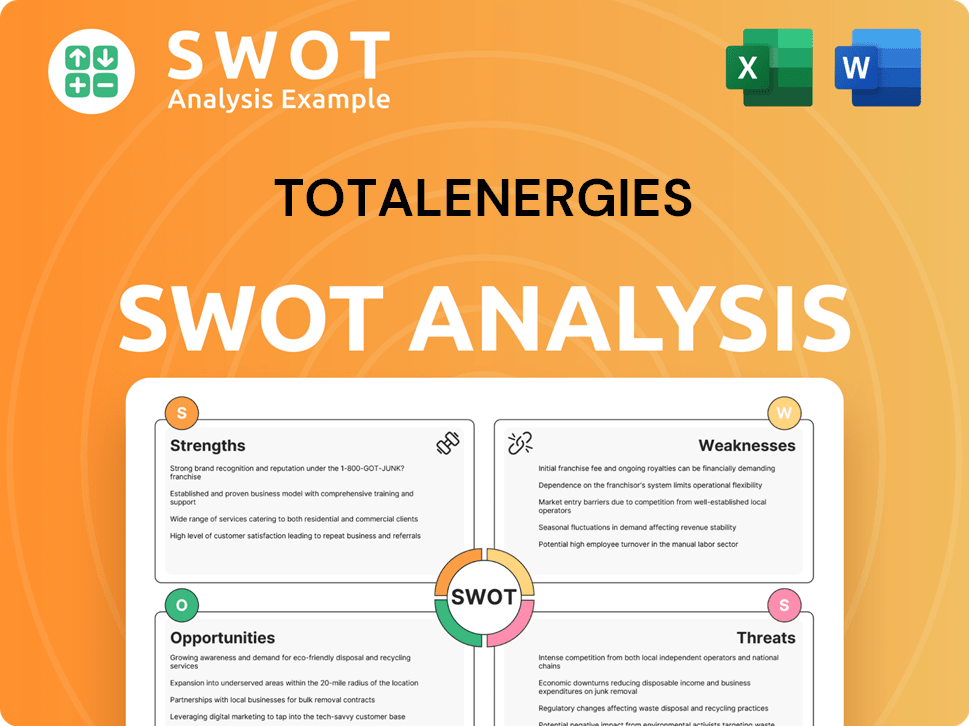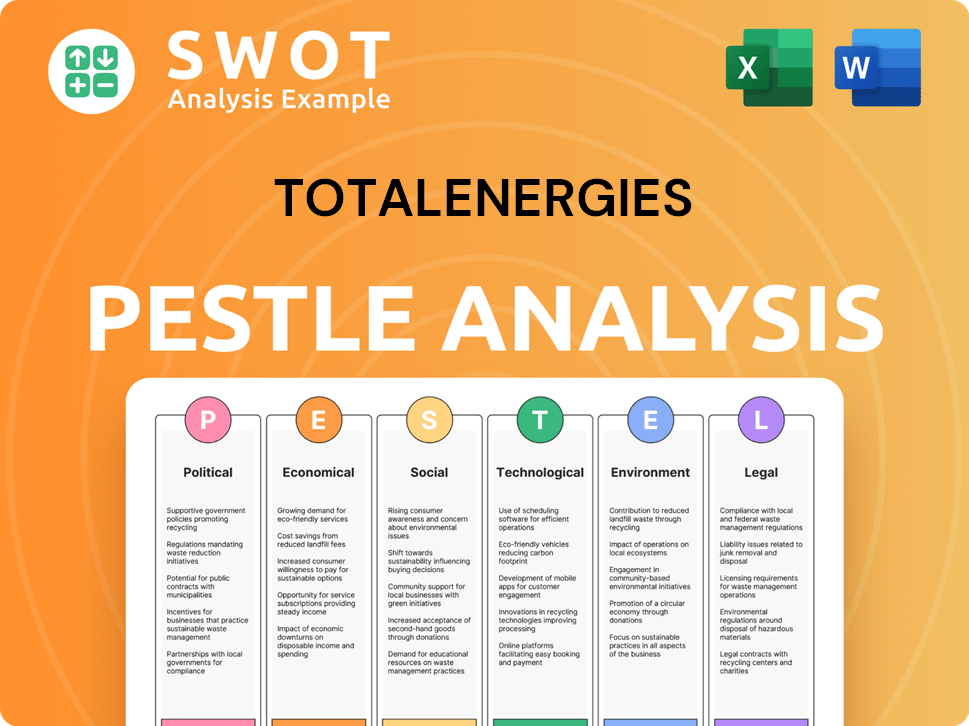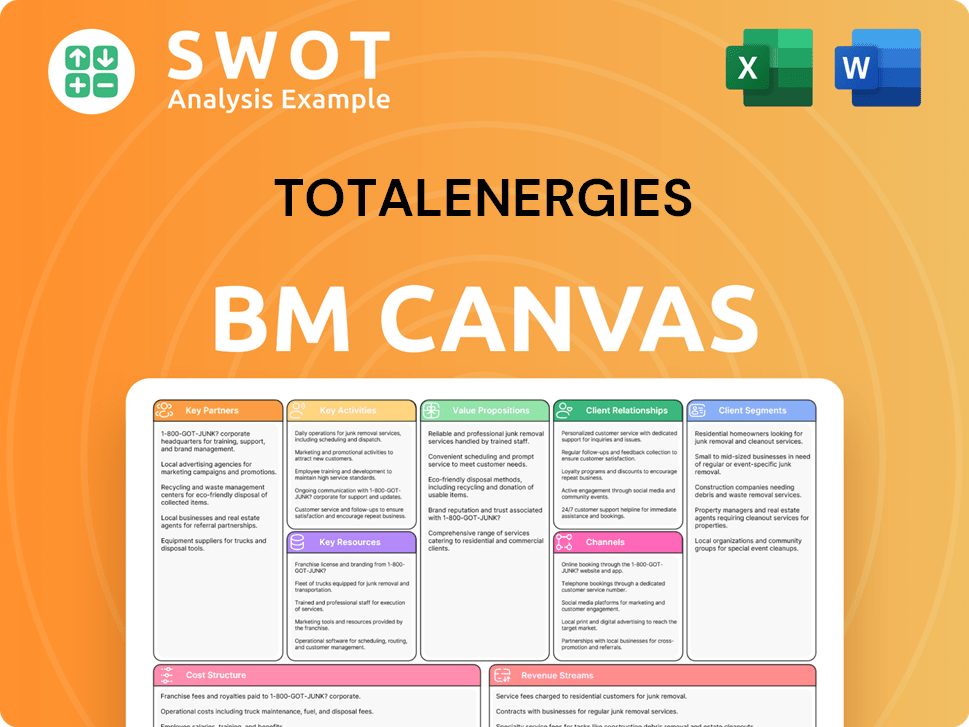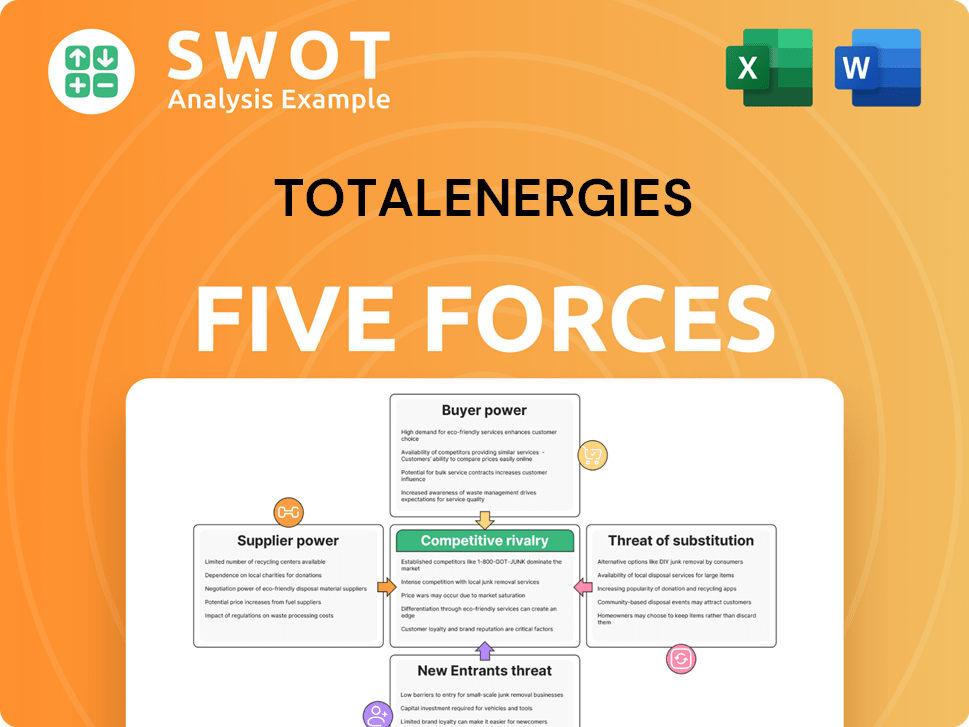TotalEnergies Bundle
How Does TotalEnergies Navigate the Shifting Energy Terrain?
The energy sector is in constant flux, demanding that companies adapt or risk obsolescence. TotalEnergies, a global energy giant, is at the forefront of this transformation, but what does its competitive landscape look like? Understanding the TotalEnergies SWOT Analysis is crucial to grasping its position in the market.

This analysis delves into the TotalEnergies competitive landscape, examining its key TotalEnergies competitors and the strategies it employs to maintain its market share. We'll explore the company's TotalEnergies market analysis, including its performance review and strategic partnerships within the energy industry competition. Furthermore, the examination will cover the company's position relative to other oil and gas companies and its investments in the renewable energy market, offering insights into its future prospects.
Where Does TotalEnergies’ Stand in the Current Market?
TotalEnergies maintains a strong position in the global energy market, balancing traditional oil and gas operations with a growing focus on renewable energy sources. The company's integrated model allows it to participate across the energy value chain, from exploration and production to refining, distribution, and electricity generation. This diversification helps to mitigate risks associated with fluctuating commodity prices and the ongoing energy transition.
In 2023, TotalEnergies reported an adjusted net income of $23.2 billion, showcasing its financial strength and operational efficiency. The company's value proposition centers on providing energy solutions to a diverse customer base while actively reducing its carbon footprint. This includes investments in renewable energy projects and the development of lower-carbon products and services.
TotalEnergies's core operations span the energy spectrum, including upstream (exploration and production), downstream (refining and petrochemicals), and integrated gas, renewables & power. The company's upstream segment is a significant revenue generator, with substantial oil and natural gas production. Downstream operations, particularly in Europe, provide a stable revenue stream through refining and petrochemical activities. TotalEnergies is also expanding its presence in the renewable energy market, aiming for significant growth in its renewable generation capacity.
TotalEnergies is one of the largest publicly traded integrated oil and gas companies globally. It holds a significant market share in both oil and natural gas production. The company's market position is enhanced by its diverse geographical presence and integrated operations.
The company's financial performance reflects its strong operational capabilities and strategic adaptability. TotalEnergies's revenue streams are diversified, providing resilience against market volatility. The company's profitability is supported by its integrated business model and efficient cost management.
TotalEnergies has a widespread geographical presence, with operations across Europe, North America, South America, Africa, the Middle East, and Asia. This global footprint allows the company to access diverse resources and markets. Its presence in key regions supports its overall market position.
TotalEnergies is strategically shifting towards a lower-carbon energy mix, with significant investments in renewable energy. The company aims to increase its gross renewable generation capacity to 35 GW by 2025 and 100 GW by 2030. This strategic shift is reflected in its capital expenditure allocation, with around 35% of total investments projected for renewables and electricity in 2024.
TotalEnergies is actively transforming its business model to adapt to the changing energy landscape. The company is focusing on expanding its renewable energy portfolio and reducing its carbon emissions. TotalEnergies's strategic partnerships and investments in new technologies are crucial for maintaining its competitive edge.
- Increasing investments in solar and wind power projects.
- Developing electric vehicle charging infrastructure.
- Focusing on carbon capture and storage technologies.
- Exploring strategic partnerships to enhance its renewable energy capabilities.
The Revenue Streams & Business Model of TotalEnergies highlights the company's diverse revenue sources and its integrated approach to the energy market. This integrated model, combined with a focus on renewable energy, positions TotalEnergies to navigate the evolving energy industry effectively. TotalEnergies faces both challenges and opportunities in the current market, including the need to balance traditional hydrocarbon production with the growth of renewable energy sources. The company's ability to adapt and innovate will be critical to its long-term success in the TotalEnergies competitive landscape and the broader energy industry competition.
TotalEnergies SWOT Analysis
- Complete SWOT Breakdown
- Fully Customizable
- Editable in Excel & Word
- Professional Formatting
- Investor-Ready Format

Who Are the Main Competitors Challenging TotalEnergies?
The TotalEnergies competitive landscape is shaped by a diverse group of players across the energy sector. This includes integrated energy majors, specialized renewable energy developers, and national oil companies. Understanding these TotalEnergies competitors is crucial for assessing the company's strategic positioning and potential for future growth.
TotalEnergies market analysis reveals a complex interplay of competition in both traditional and emerging energy markets. The company faces significant challenges and opportunities as it navigates the transition to a lower-carbon future. This competitive environment influences its strategic decisions, investment choices, and overall financial performance.
Direct competitors include ExxonMobil, Shell, BP, and Chevron. These companies have integrated business models. They compete in exploration, production, refining, and marketing. For example, Shell is also investing heavily in renewable energy.
TotalEnergies competes with specialized renewable energy companies like Ørsted, Iberdrola, and Enel Green Power. These companies focus on specific renewable technologies. Iberdrola, for example, is a leader in wind power and smart grids.
NOCs such as Saudi Aramco and ADNOC significantly influence global oil and gas markets. They have vast reserves and production capacities. While not always direct competitors, their scale impacts the market dynamics that TotalEnergies operates within.
New entrants in green hydrogen and advanced biofuels are disrupting the traditional landscape. These companies often use innovative technologies. They also employ new business models to gain a foothold in the market.
Mergers and alliances are common strategies to gain market share. Joint ventures in offshore wind projects are a good example. These partnerships allow companies to leverage each other's strengths.
The energy industry competition is intense and constantly evolving. Companies are adapting to changing market conditions. They are also responding to the growing demand for sustainable energy solutions.
The competitive landscape is dynamic, with companies constantly adjusting their strategies. For instance, TotalEnergies has been increasing its investments in renewable energy, aiming to reduce its carbon footprint and diversify its portfolio. For more insights into TotalEnergies' strategic direction, consider reading about the Growth Strategy of TotalEnergies. The company's ability to adapt and innovate will be critical in maintaining its position in the evolving energy market. In 2024, Shell's capital expenditure on renewables and energy solutions was approximately $5 billion, highlighting the scale of competition in this area. In 2023, ExxonMobil's production of oil equivalent was around 3.8 million barrels per day, showcasing its continued dominance in the oil and gas sector. Ørsted's revenue in 2024 is projected to be around $18 billion, demonstrating the growth of renewable energy companies.
Several factors influence the competitive dynamics within the energy sector. These include technological innovation, regulatory changes, and geopolitical events.
- Market Share Analysis: Assessing market share is crucial for understanding competitive positioning.
- Financial Performance Review: Analyzing financial results helps evaluate the profitability and sustainability of competitors.
- Strategic Partnerships: Alliances and joint ventures can enhance competitiveness.
- Geographical Presence: The extent of a company's operations across different regions affects its market reach.
TotalEnergies PESTLE Analysis
- Covers All 6 PESTLE Categories
- No Research Needed – Save Hours of Work
- Built by Experts, Trusted by Consultants
- Instant Download, Ready to Use
- 100% Editable, Fully Customizable

What Gives TotalEnergies a Competitive Edge Over Its Rivals?
Understanding the TotalEnergies competitive landscape involves recognizing its multifaceted strengths. The company, formerly known as Total, has strategically positioned itself within the energy industry competition. This positioning allows it to navigate the evolving demands of the global energy market. A key aspect of its strategy is a focus on both traditional and renewable energy sources.
The company's integrated business model is a significant differentiator. It spans the entire energy value chain, from exploration and production to refining and marketing. This integration provides operational efficiencies and risk diversification. It also allows for a more stable revenue base compared to companies focused solely on one segment.
TotalEnergies market analysis reveals a company that is actively adapting to the energy transition. This adaptation involves significant investments in renewable energy and low-carbon technologies. The company's global presence and financial resources further enhance its competitive position. These factors are crucial for its long-term success in a dynamic market.
TotalEnergies' integrated model spans the entire energy value chain. This approach provides operational synergies and risk diversification. It also allows for a more stable revenue stream compared to competitors focusing on specific segments.
The company operates in over 120 countries, providing a significant advantage. This global footprint enables adaptation to regional market demands. It also helps in optimizing resource allocation and mitigating geopolitical risks.
TotalEnergies benefits from strong brand equity and a long-standing reputation. This fosters customer loyalty and facilitates new market entry. The company's history and reliability are key assets in the energy sector.
The company's substantial financial resources and access to capital markets are critical. These enable large-scale, capital-intensive projects. This includes investments in both traditional and renewable energy projects.
The company's focus on technological innovation, particularly in areas such as carbon capture and green hydrogen, is a key competitive advantage. This commitment to sustainability and renewable energy enhances its appeal to investors and consumers. The company's strategic moves, as highlighted in Growth Strategy of TotalEnergies, are continuously evolving to meet the demands of the energy transition. These advantages are further supported by its extensive distribution networks and strategic partnerships.
TotalEnergies leverages several competitive advantages to maintain its position in the TotalEnergies competitive landscape. These advantages include an integrated business model, a global presence, and strong financial resources.
- Integrated Business Model: Spans the entire energy value chain, offering operational synergies and risk diversification.
- Global Presence: Operates in over 120 countries, enabling adaptation to regional markets and mitigating geopolitical risks.
- Financial Strength: Substantial resources for large-scale projects in both traditional and renewable energy.
- Technological Innovation: Focus on carbon capture, advanced biofuels, and green hydrogen.
- Sustainability Initiatives: Commitment to renewable energy and carbon emissions targets.
TotalEnergies Business Model Canvas
- Complete 9-Block Business Model Canvas
- Effortlessly Communicate Your Business Strategy
- Investor-Ready BMC Format
- 100% Editable and Customizable
- Clear and Structured Layout

What Industry Trends Are Reshaping TotalEnergies’s Competitive Landscape?
The global energy industry is experiencing a period of significant transformation, creating both challenges and opportunities for companies like TotalEnergies. The shift towards cleaner energy sources, driven by environmental concerns and regulatory changes, is reshaping the competitive landscape. This requires strategic adaptation and investment in renewable energy and low-carbon solutions to maintain market relevance and financial performance. Understanding the Owners & Shareholders of TotalEnergies is crucial for assessing the company's strategic direction and long-term value.
TotalEnergies faces risks associated with the decline in fossil fuel demand and the volatility of oil and gas prices. Simultaneously, the company is presented with opportunities in the growing markets for renewable energy, electric vehicle charging infrastructure, and green hydrogen. Its ability to navigate these shifts and capitalize on emerging trends will determine its future success. The company’s strategic initiatives, including significant investments in renewable energy, are key to its long-term competitiveness and sustainability.
The energy industry is transitioning toward renewable sources, driven by climate change and policy changes. There is increasing demand for electric vehicles and green hydrogen. Digitalization and smart grids are also becoming more prevalent, impacting operations and service offerings.
Challenges include managing the decline in fossil fuel demand, adapting to stricter emissions standards, and dealing with geopolitical risks. Supply chain disruptions and the volatility of energy prices pose additional threats. Competition from renewable energy companies is intensifying.
Opportunities exist in the expansion of renewable energy projects, electric vehicle charging infrastructure, and green hydrogen production. Developing innovative business models and exploring emerging markets are also key. Technological advancements offer avenues for operational optimization and new service development.
TotalEnergies aims to become a multi-energy company, targeting 100 GW of renewable generation capacity by 2030. It is diversifying energy sources and strengthening supply chain resilience. The company focuses on reducing Scope 1+2 emissions by 20% by 2030.
TotalEnergies' strategy involves a dual approach: balancing its profitable hydrocarbon assets with aggressive expansion into new energies. This includes significant investments in solar power, wind energy, and other renewable projects. The company is also focused on developing integrated renewable energy solutions for industrial clients, enhancing its competitive position in the renewable energy market.
- Investing in renewable energy projects globally, including solar and wind farms.
- Developing electric vehicle charging infrastructure and green hydrogen production.
- Exploring strategic partnerships to enhance technological capabilities and market reach.
- Implementing digital solutions to optimize operations and improve efficiency.
TotalEnergies Porter's Five Forces Analysis
- Covers All 5 Competitive Forces in Detail
- Structured for Consultants, Students, and Founders
- 100% Editable in Microsoft Word & Excel
- Instant Digital Download – Use Immediately
- Compatible with Mac & PC – Fully Unlocked

Related Blogs
- What are Mission Vision & Core Values of TotalEnergies Company?
- What is Growth Strategy and Future Prospects of TotalEnergies Company?
- How Does TotalEnergies Company Work?
- What is Sales and Marketing Strategy of TotalEnergies Company?
- What is Brief History of TotalEnergies Company?
- Who Owns TotalEnergies Company?
- What is Customer Demographics and Target Market of TotalEnergies Company?
Disclaimer
All information, articles, and product details provided on this website are for general informational and educational purposes only. We do not claim any ownership over, nor do we intend to infringe upon, any trademarks, copyrights, logos, brand names, or other intellectual property mentioned or depicted on this site. Such intellectual property remains the property of its respective owners, and any references here are made solely for identification or informational purposes, without implying any affiliation, endorsement, or partnership.
We make no representations or warranties, express or implied, regarding the accuracy, completeness, or suitability of any content or products presented. Nothing on this website should be construed as legal, tax, investment, financial, medical, or other professional advice. In addition, no part of this site—including articles or product references—constitutes a solicitation, recommendation, endorsement, advertisement, or offer to buy or sell any securities, franchises, or other financial instruments, particularly in jurisdictions where such activity would be unlawful.
All content is of a general nature and may not address the specific circumstances of any individual or entity. It is not a substitute for professional advice or services. Any actions you take based on the information provided here are strictly at your own risk. You accept full responsibility for any decisions or outcomes arising from your use of this website and agree to release us from any liability in connection with your use of, or reliance upon, the content or products found herein.